Seasonal Variations and Drivers of Total Nitrogen and Phosphorus in China’s Surface Waters
Abstract
1. Introduction
2. Study Area and Data
2.1. Overview of the Study Area
2.2. Data Sources and Processing
2.2.1. Measured Water Quality Data
2.2.2. Meteorological Data
2.2.3. Land-Use Data
2.2.4. Soil Type Data
2.2.5. Fertilization Data
3. Methods
3.1. Spatial and Temporal Patterns Analysis of TP:TN
3.2. Influencing Factors Analysis of TP:TN
3.2.1. Pearson Correlation Analysis
3.2.2. Random Forest Model
3.2.3. Geographically Weighted Regression Analysis
3.3. Model Evaluations
4. Results
4.1. General Characteristics of TP and TN Distribution in China
4.2. Spatial and Temporal Patterns of TP:TN in China
4.2.1. Seasonal Variations
4.2.2. Cluster Analysis Results
5. Discussions
5.1. Influencing Factors
5.2. Spatial Heterogeneity of Influencing Factors
6. Conclusions
Supplementary Materials
Author Contributions
Funding
Data Availability Statement
Acknowledgments
Conflicts of Interest
References
- Wang, S.; Qing, B. Research progress on remote sensing monitoring of lake water quality parameters. Environ. Sci. 2023, 44, 1228–1237. [Google Scholar]
- Levallois, P.; Villanueva, C.M. Drinking Water Quality and Human Health: An Editorial. Int. J. Environ. Res. Public Health 2019, 16, 631. [Google Scholar] [CrossRef] [PubMed]
- Xu, Z. Hydrological models: Past, present and future. J. Beijing Norm. Univ. (Nat. Sci.) 2010, 46, 278–289. [Google Scholar]
- Fu, C.; Zhong, C.; Deng, C. Analysis on Cause of the Eutrophication of Water Body. J. Civ. Environ. Eng. 2005, 27, 128–131. [Google Scholar]
- Xie, L.; Wu, D.; Zhang, Y. Analysis and Evaluation of China’s Rural Domestic Sewage Treatment Technology. J. Ecol. Rural. Environ. 2018, 34, 865–870. [Google Scholar]
- Leaf, S.S.; Chatterjee, R. Developing a strategy on eutrophication. Water Sci. Technol. 1999, 39, 307–314. [Google Scholar] [CrossRef]
- Huang, X.; Li, H.; Jin, B. Hydrology; Higher Education Press: Beijing, China, 2001. [Google Scholar]
- Chen, W.; Chen, Y.; Huang, H.; Lu, Y.; Khorram, M.S.; Zhao, W.; Wang, D.; Qi, S.; Jin, B.; Zhang, G. Occurrence of N-Nitrosamines in the Pearl River delta of China: Characterization and evaluation of different sources. Water Res. 2019, 164, 114896.1–114896.10. [Google Scholar] [CrossRef]
- Report on the State of the Ecology and Environment in China 2022; Ministry of Ecology and Environment of the People’s Republic of China: Beijing, China, 2023; pp. 11–15.
- Cui, M.; Guo, Q.; Wei, R. Human-driven spatiotemporal distribution of phosphorus flux in the environment of a mega river basin. Sci. Total Environ. 2021, 752, 141781. [Google Scholar] [CrossRef]
- Nan, S.; Li, J.; Zhang, L. Distribution characteristics of phosphorus in the Yarlung Zangbo River basin. Water 2018, 10, 913. [Google Scholar] [CrossRef]
- Huang, Z.; Jiang, S.; Gao, H.; Zhang, Q.; Huang, J.; Liu, Q. Analysing the spatial and temporal variations and influencing factors of the water quality in the hilly watershed of Poyang Lake. Environ. Sci. Technol. 2022, 45, 47–57. [Google Scholar]
- Yang, C.; He, B.; Duan, W.; Li, B.; Chen, W.; Yang, G. Analysing the spatial and temporal variations and influencing factors of the water quality in a typical hilly water source of lake Taihu basin: A case study in Pingqiao river watershed. Resour. Environ. Yangtze Basin 2017, 26, 273–281. [Google Scholar]
- Li, Y.; Zhang, Z.; Cheng, J.; Zou, L.; Zhang, Q.; Zhang, M.; Gong, Z.; Xie, S.; Cai, Y. Water quality change and driving forces of Lake Hongze from 2012 to 2018. J. Lake Sci. 2021, 33, 715–726. [Google Scholar]
- Li, Z.; Yu, X.; Liu, Q.; Jing, G. Phosphorus output characteristics of special rainfall in a typical small watershed in the Yimeng Mountains. Environ. Sci. 2012, 33, 1152–1158. [Google Scholar]
- Li, L.; Lu, S.; Meng, W.; Liu, X.; Guo, X.; Wang, Z. Eutrophication and control measures of key lakes in the Yangtze River Basin. Sci. Technol. Rev. 2017, 35, 13–22. [Google Scholar]
- Tang, C. Hydrology of Chinese Rivers; Science Press: Beijing, China, 1998. [Google Scholar]
- Fang, Z.; Su, J.; Zhao, H.; Hu, L.; Li, X. Non-point source nitrogen and phosphorus output characteristics of typical land use in small watersheds in red soil hilly areas. Environ. Sci. 2021, 42, 5394–5404. [Google Scholar]
- Shi, H.; Shao, M. Soil and water loss from the Loess Plateau in China. J. Arid. Environ. 2000, 45, 9–20. [Google Scholar] [CrossRef]
- Wei, W.; Chen, L.; Fu, B.; Huang, Z.; Wu, D.; Gui, L. The effect of land uses and rainfall regimes on runoff and soil erosion in the semi-arid loess hilly area, China. J. Hydrol. 2007, 335, 247–258. [Google Scholar] [CrossRef]
- Pratt, B.; Chang, H. Effects of land cover, topography, and built structure on seasonal water quality at multiple spatial scales. J. Hazard. Mater. 2012, 209–210, 48–58. [Google Scholar] [CrossRef]
- Li, X.; Lei, Q.; Zhou, J.; Zhang, Y.; Li, Y.; Hu, W.; Wu, S.; Zhai, L.; Wang, H.; Liu, H. Effects of rainfall intensity on nitrogen and phosphorus emissions in Fengyu River in the Erhai Basin. Environ. Sci. 2019, 40, 5375–5383. [Google Scholar]
- Funk, C.; Peterson, P.; Landsfeld, M.; Pedreros, D.; Verdin, J.; Shukla, S.; Husak, G.; Rowland, J.; Harrison, L.; Hoell, A. The climate hazards infrared precipitation with stations—A new environmental record for monitoring extremes. Sci. Data 2015, 2, 150066. [Google Scholar] [CrossRef]
- Liu, J.; Zhang, Z.; Xu, X.; Kuang, W.; Zhou, W.; Zhang, S.; Li, R.; Yan, C.; Yu, D.; Wu, S.; et al. Spatial Patterns and Driving Forces of Land Use Change in China in the Early 21st Century. Acta Geogr. Sin. 2009, 64, 1411–1420. [Google Scholar] [CrossRef]
- Xi, C.; Zhang, S. Brief introduction on achievements in national soil survey project since 1979. Acta Pedol. Sin. 1994, 31, 330–335. [Google Scholar]
- Yu, Z.; Liu, J.; Kattel, G. Historical nitrogen fertilizer use in China from 1952 to 2018. Earth Syst. Sci. Data 2022, 14, 5179–5194. [Google Scholar] [CrossRef]
- Bauwe, A.; Tiemeyer, B.; Kahle, P.; Lennartz, B. Classifying hydrological events to quantify their impact on nitrate leaching across three spatial scales. J. Hydrol. 2015, 531, 589–601. [Google Scholar] [CrossRef]
- Lu, H.; Feng, Q. Survey on random forest algorithms. J. Hebei Acad. Sci. 2019, 36, 37–41. [Google Scholar]
- Zhuo, Y.; Zeng, W.; Ma, B. Spatiotemporal variation and influencing factors of nitrogen and phosphorus in lake sediments in China since 1850. J. Clean. Prod. 2022, 368, 133170. [Google Scholar] [CrossRef]
- Fernández-Raga, M.; Palencia, C.; Keesstra, S.; Jordán, A.; Cerdà, A. Splash erosion: A review with unanswered questions. Earth-Sci. Rev. 2017, 171, 463–477. [Google Scholar] [CrossRef]
- Wu, L.; Peng, M.; Qiao, S.; Ma, X.Y. Effects of rainfall intensity and slope gradient on runoff and sediment yield characteristics of bare loess soil. Environ. Sci. Pollut. Res. 2018, 25, 3480–3487. [Google Scholar] [CrossRef]
- Mengistu, S.G.; Creed, I.F.; Webster, K.L.; Eric, E.; Beall, F.D. Searching for similarity in topographic controls on carbon, nitrogen and phosphorus export from forested headwater catchments. Hydrol. Process. 2014, 28, 3201–3216. [Google Scholar] [CrossRef]
- Liao, Z.; Lu, Y.; Chen, Z.; Ding, R.; Wu, Y.; Wei, D.; Gao, H.; Xu, H.; Wen, H.; Hu, H. Characteristics of spatial-temporal variation in the ecological risk of aquatic organisms for ammonia nitrogen in the Yellow River Basin. Res. Environ. Sci. 2023, 37, 42–50. [Google Scholar]
- Hongjun, D.; Tao, S.; Kun, Z.; Wen, G. Research on Rural Nonpoint Source Pollution in the Process of Urban-Rural Integration in the Economically-Developed Area in China Based on the Improved STIRPAT Model. Sustainability 2015, 7, 782–793. [Google Scholar] [CrossRef]
- Essaid, H.I.; Bekins, B.A.; Cozzarelli, I.M. Organic contaminant transport and fate in the subsurface: Evolution of knowledge and understanding. Water Resour. Res. 2015, 51, 4861–4902. [Google Scholar] [CrossRef]
- Liu, R.; Wang, J.; Shi, J.; Chen, Y.; Sun, C.; Zhang, P.; Shen, Z. Runoff characteristics and nutrient loss mechanism from plain farmland under simulated rainfall conditions. Sci. Total Environ. 2014, 468–469, 1069–1077. [Google Scholar] [CrossRef]
- Shen, Z.; Qiu, J.; Hong, Q.; Chen, L. Simulation of spatial and temporal distributions of non-point source pollution load in the Three Gorges Reservoir Region. Sci. Total Environ. 2014, 493, 138–146. [Google Scholar] [CrossRef]
- Sawicz, K.; Wagener, T.; Sivapalan, M.; Troch, P.A.; Carrillo, G. Catchment classification: Empirical analysis of hydrologic similarity based on catchment function in the eastern USA. Hydrol. Earth Syst. Sci. Discuss. 2011, 15, 2895–2911. [Google Scholar] [CrossRef]
- Yang, J.; Liang, J.; Yang, G.; Feng, Y.; Ren, G.; Ren, C.; Han, X.; Wang, X. Characteristics of Non-Point Source Pollution under Different Land Use Types. Sustainability 2020, 12, 2012. [Google Scholar] [CrossRef]
- Ning, J.; Huang, Y.; Li, G.; Chen, Z.; Wang, J. Characteristics of soil erosion and nitrogen loss in vegetable fields under natural rainfall. Environ. Sci. 2023, 44, 293–302. [Google Scholar]
- Huang, C.; Huang, X.; Peng, C.; Zhou, Z.; Teng, M.; Wang, P. Land use/cover change in the Three Gorges Reservoir area, China: Reconciling the land use conflicts between development and protection. Catena 2019, 175, 388–399. [Google Scholar] [CrossRef]
- Rothwell, J.J.; Dise, N.B.; Taylor, K.G.; Allott, T.E.H.; Neal, C. A spatial and seasonal assessment of river water chemistry across North West England. Sci. Total Environ. 2009, 408, 841–855. [Google Scholar] [CrossRef]
- Jiao, X.; Peng, T.; Li, S.; Zhang, L.; Gu, Z.; Zhang, X.; Wang, S. A preliminary study on the erosive rainfall threshold of karst slopes. J. Soil Water Conserv. 2023, 37, 57–63. [Google Scholar]
- Guo, J.H.; Liu, X.J.; Zhang, Y.; Shen, J.L.; Han, W.X.; Zhang, W.F.; Christie, P.; Goulding, K.W.T.; Vitousek, P.M.; Zhang, F.S. Significant Acidification in Major Chinese Croplands. Science 2010, 327, 1008–1010. [Google Scholar] [CrossRef] [PubMed]
- Turnbull, L.; Wainwright, J.; Brazier, R.E. A conceptual framework for understanding semi-arid land degradation: Ecohydrological interactions across multiple-space and time scales. Ecohydrology 2008, 1, 23–34. [Google Scholar] [CrossRef]
- Bai, J.; Deng, W.; Zhu, Y.; Wang, Q. Spatial variability of nitrogen in soils from land/Inland water ecotones. Commun. Soil Sci. Plant Anal. 2004, 35, 735–749. [Google Scholar] [CrossRef]
- Suescun, D.; Villegas, J.; Leon, J.D.; Florez, C.P.; Garcia-Leoz, V.; Correa-Londono, G.A. Vegetation cover and rainfall seasonality impact nutrient loss via runoff and erosion in the Colombian Andes. Reg. Environ. Change 2017, 17, 827–839. [Google Scholar] [CrossRef]
- Jencso, K.G.; Mcglynn, B.L.; Gooseff, M.N.; Wondzell, S.M.; Bencala, K.E.; Marshall, L.A. Hydrologic connectivity between landscapes and streams: Transferring reach-and plot-scale understanding to the catchment scale. Water Resour. Res. 2009, 45, W04428. [Google Scholar] [CrossRef]
- Saco, P.M.; Rodríguez, J.; Heras, M.; Keesstra, S.D.; Rossi, M.J.J.C. Using hydrological connectivity to detect transitions and degradation thresholds: Applications to dryland systems. Catena 2020, 186, 104354. [Google Scholar] [CrossRef]
- Lin, C.; Ma, R.H.; Xiong, J.F. Can the watershed non-point phosphorus pollution be interpreted by critical soil properties? A new insight of different soil P states. Sci. Total Environ. 2018, 628, 870–881. [Google Scholar] [CrossRef]
- Chardon, W.J.; Schoumans, O.F. Soil texture effects on the transport of phosphorus from agricultural land in river deltas of Northern Belgium, The Netherlands and North-West Germany. Soil Use Manag. 2007, 23, 16–24. [Google Scholar] [CrossRef]
- Lisi, P.J.; Hein, C.L. Eutrophication drives divergent water clarity responses to decadal variation in lake level. Limnol. Oceanogr. 2019, 64, S49–S59. [Google Scholar] [CrossRef]
- Liu, X.; Zhang, Y.; Han, W.; Tang, A.; Shen, J.; Cui, Z.; Vitousek, P.; Erisman, J.W.; Goulding, K.; Christie, P. Enhanced nitrogen deposition over China. Nature 2013, 494, 459–462. [Google Scholar] [CrossRef]
- Catherine, M.O.; Sapna, S.; Derek, K.G. Rapid and highly variable warming of lake surface waters around the globe. Geophys. Res. Lett. 2015, 42, 10773–10781. [Google Scholar]
- Vitousek, P.M.; Porder, S.; Houlton, B.Z.; Chadwick, O.A. Terrestrial phosphorus limitation: Mechanisms, implications, and nitrogen–phosphorus interactions. Ecol. Appl. 2010, 20, 5–15. [Google Scholar] [CrossRef] [PubMed]
- Salmaso, N.; Anneville, O.; Straile, D.; Viaroli, P. European large perialpine lakes under anthropogenic pressures and climate change: Present status, research gaps and future challenges. Hydrobiologia 2018, 824, 1–32. [Google Scholar] [CrossRef]
- Shen, Z.; Chen, L.; Hong, Q.; Qiu, J.; Xie, H.; Liu, R. Assessment of nitrogen and phosphorus loads and causal factors from different land use and soil types in the Three Gorges Reservoir Area. Sci. Total Environ. 2013, 454, 383–392. [Google Scholar] [CrossRef]
- Xin, Y.; Liu, G.; Xie, Y.; Gao, Y.; Liu, B.; Shen, B. Effects of soil conservation practices on soil losses from slope farmland in northeastern China using runoff plot data. Catena 2019, 174, 417–424. [Google Scholar] [CrossRef]
- Chung, S.O.; Kim, H.S.; Kim, J.S. Model development for nutrient loading from paddy rice fields. Agric. Water Manag. 2003, 62, 1–17. [Google Scholar] [CrossRef]
- Rehman, K.; Imran, A.; Amin, I.; Afzal, M. Enhancement of oil field-produced wastewater remediation by bacterially-augmented floating treatment wetlands. Chemosphere 2019, 217, 576–583. [Google Scholar] [CrossRef]
- Niu, J.; Zhang, P.; Xing, M. Characteristics of soil erosion in purple soil slope cultivated land in the upper reaches of the Yangtze River and its prevention and control measures. J. Soil Water Conserv. 2010, 8, 64–68. [Google Scholar]
- Kwong, K.F.N.K.; Bholah, A.; Volcy, L.; Pynee, K. Nitrogen and phosphorus transport by surface runoff from a silty clay loam soil under sugarcane in the humid tropical environment of Mauritius. Agric. Ecosyst. Environ. 2002, 91, 147–157. [Google Scholar] [CrossRef]
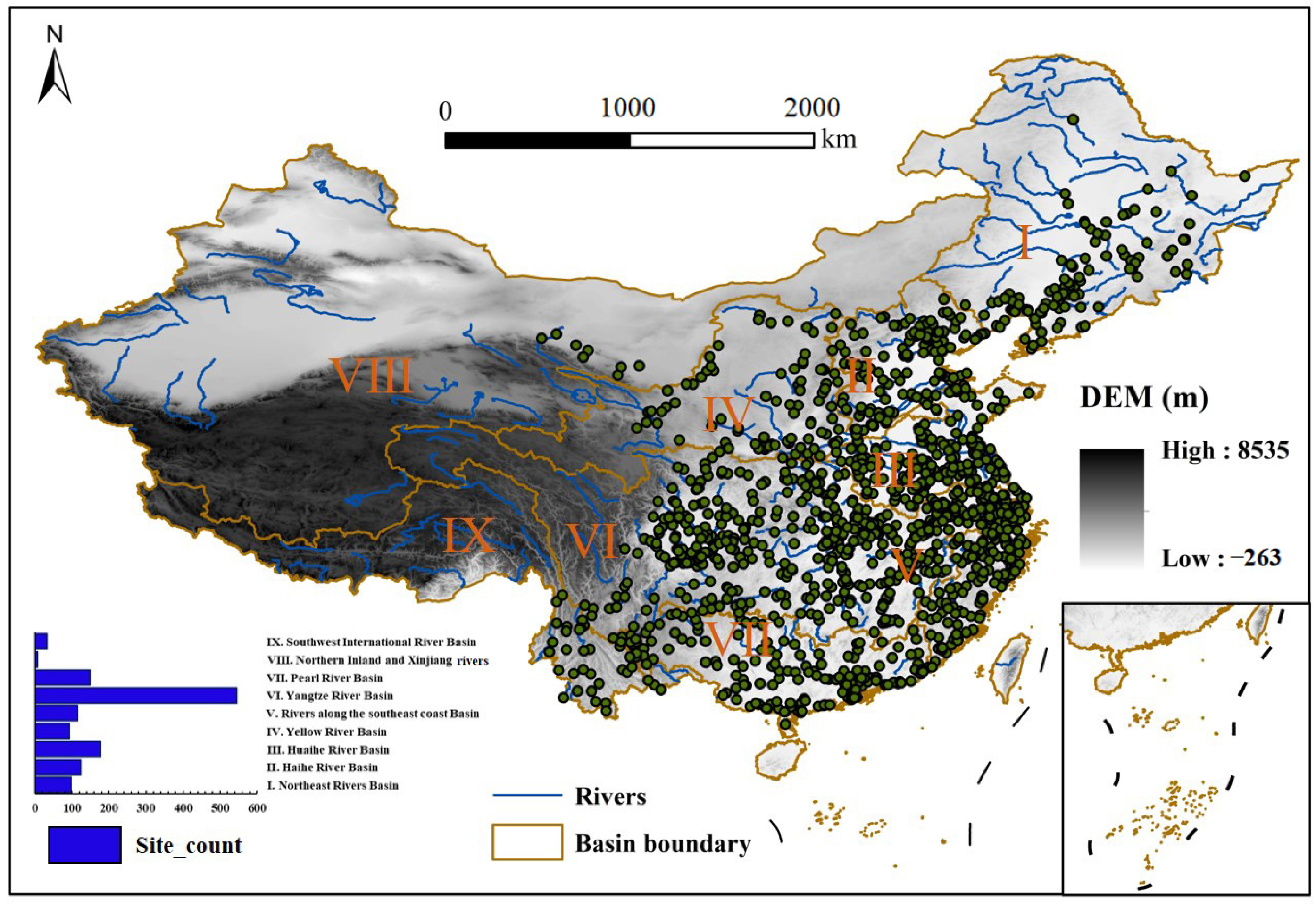
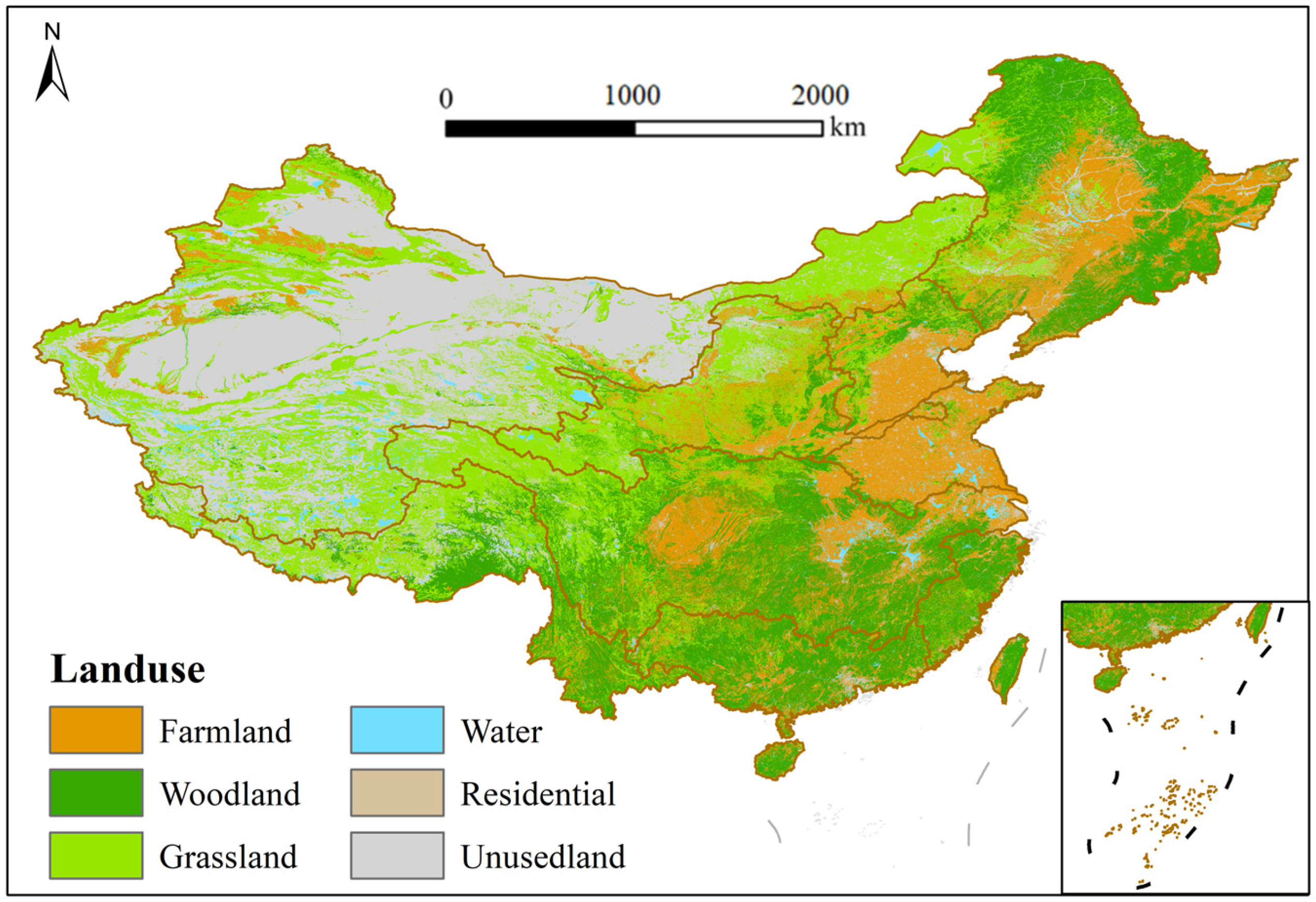

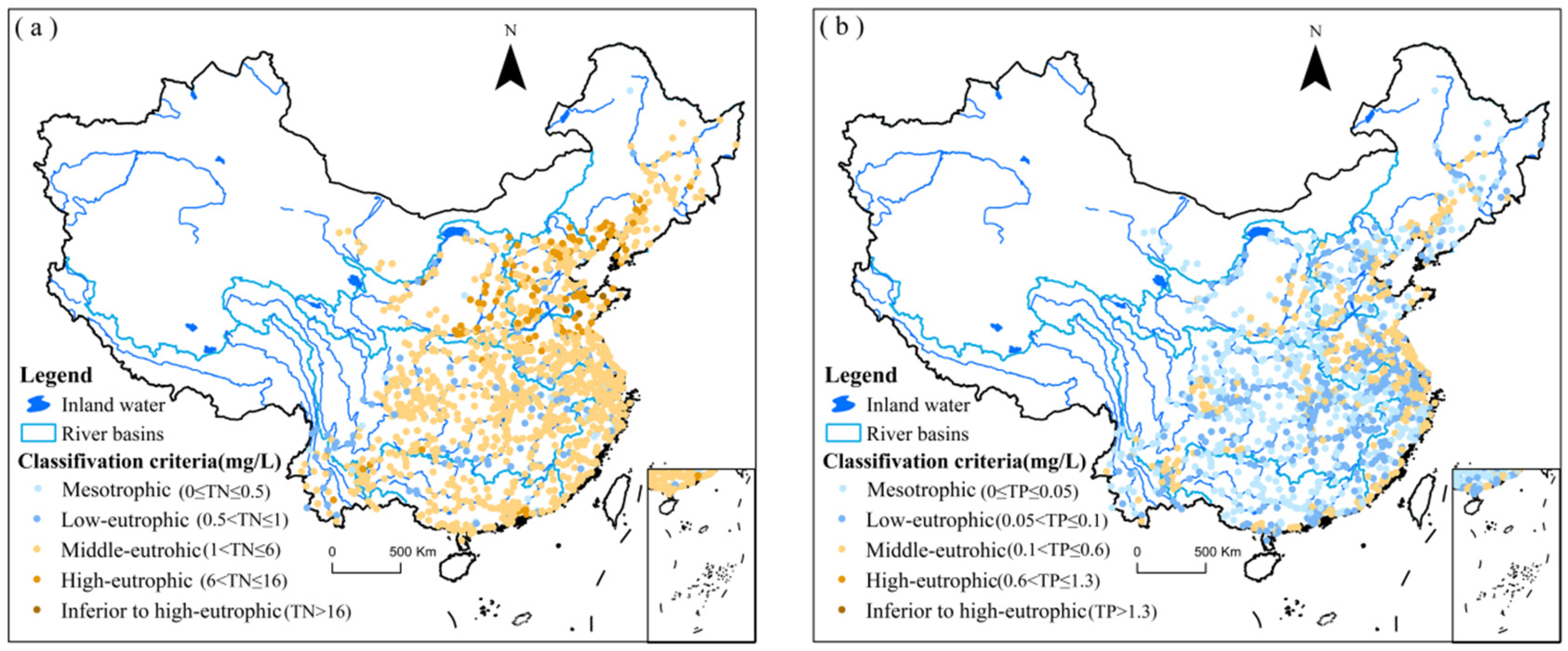
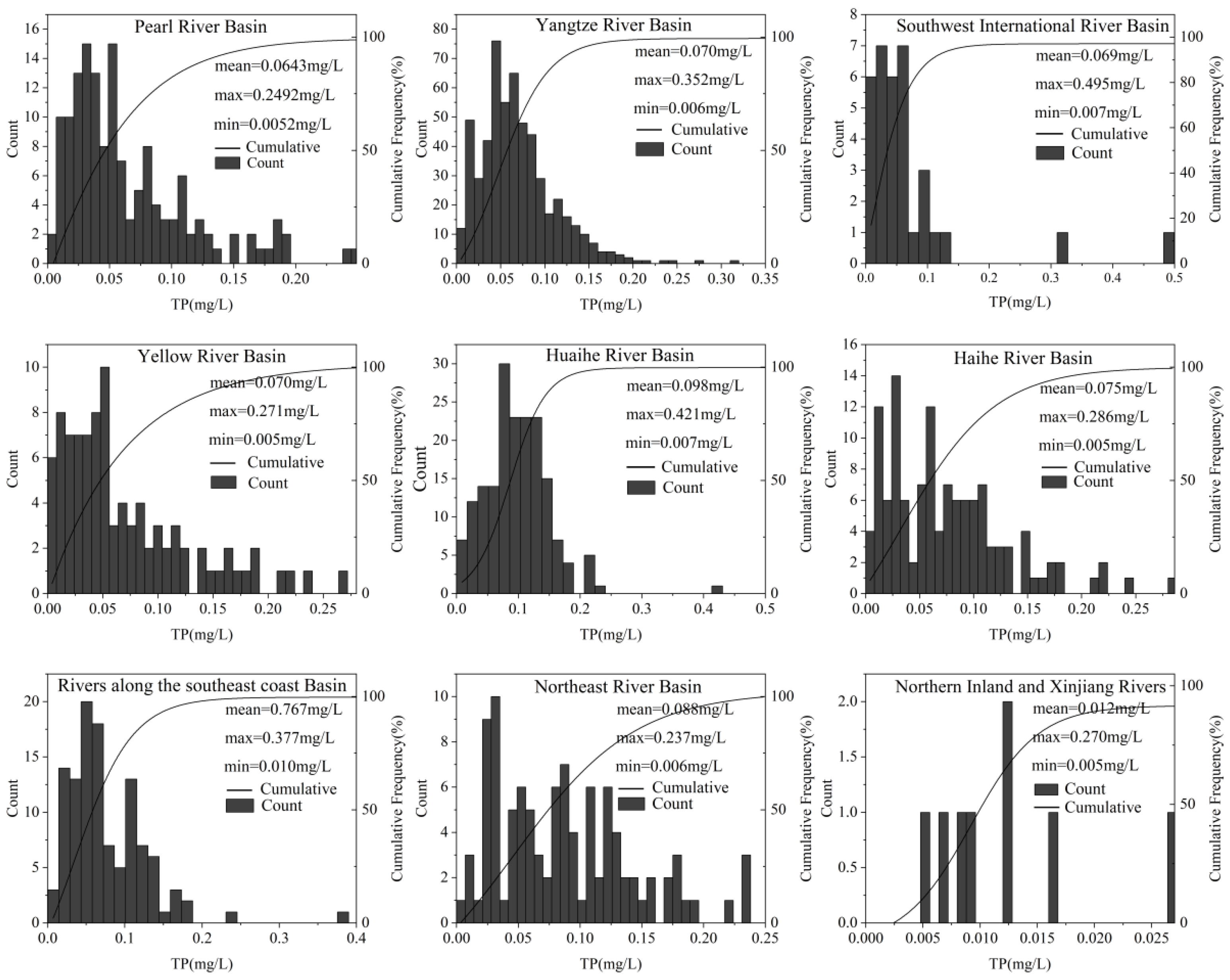

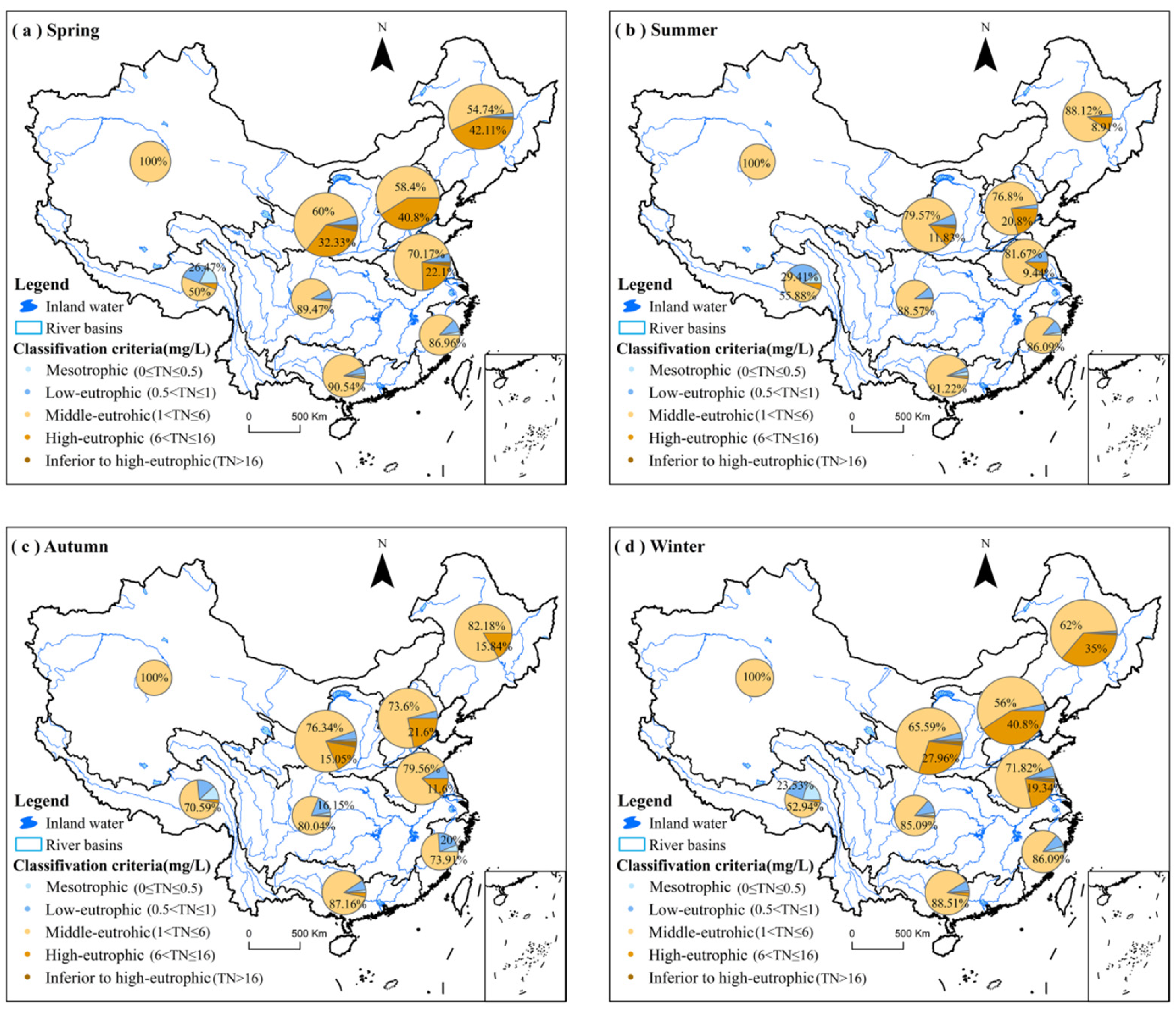

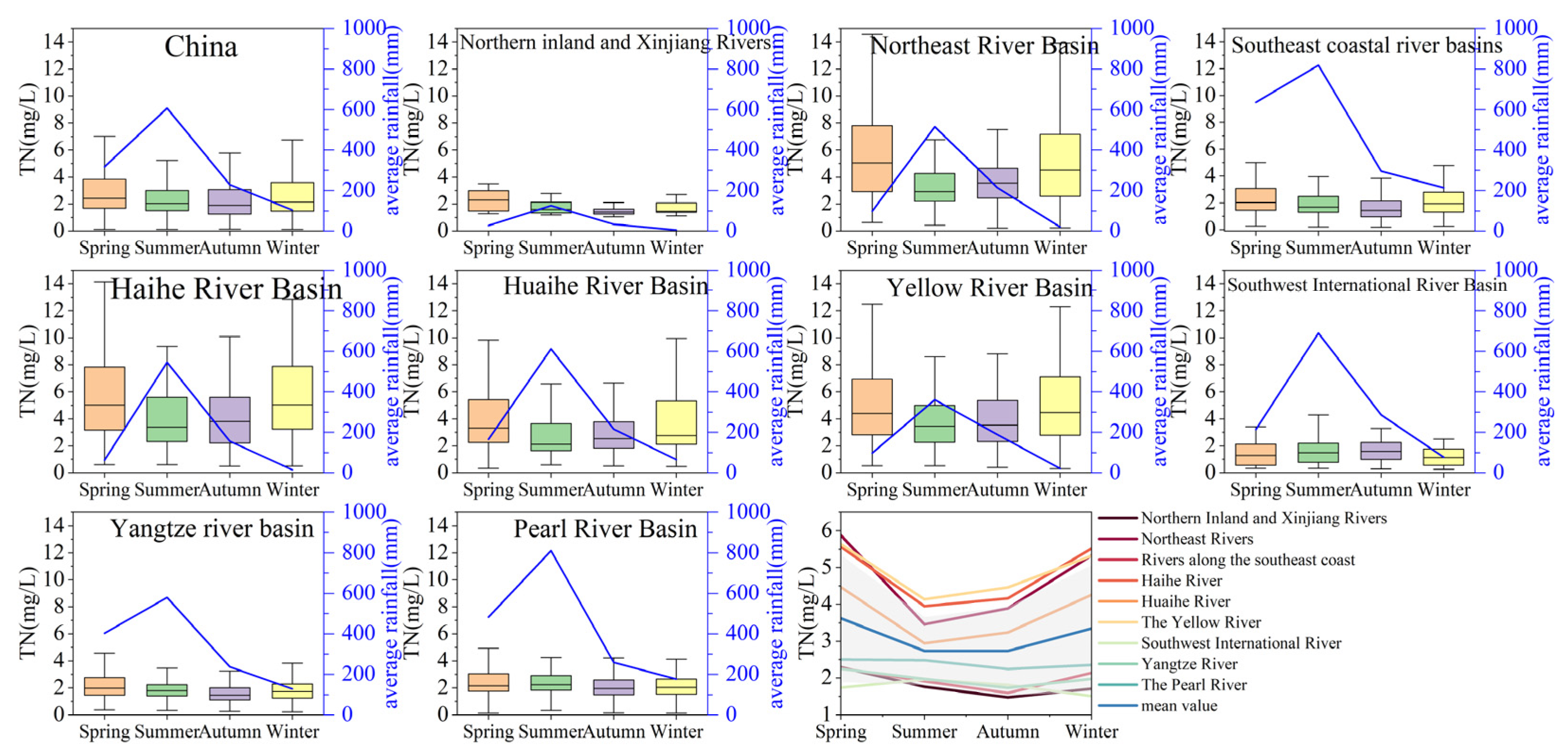

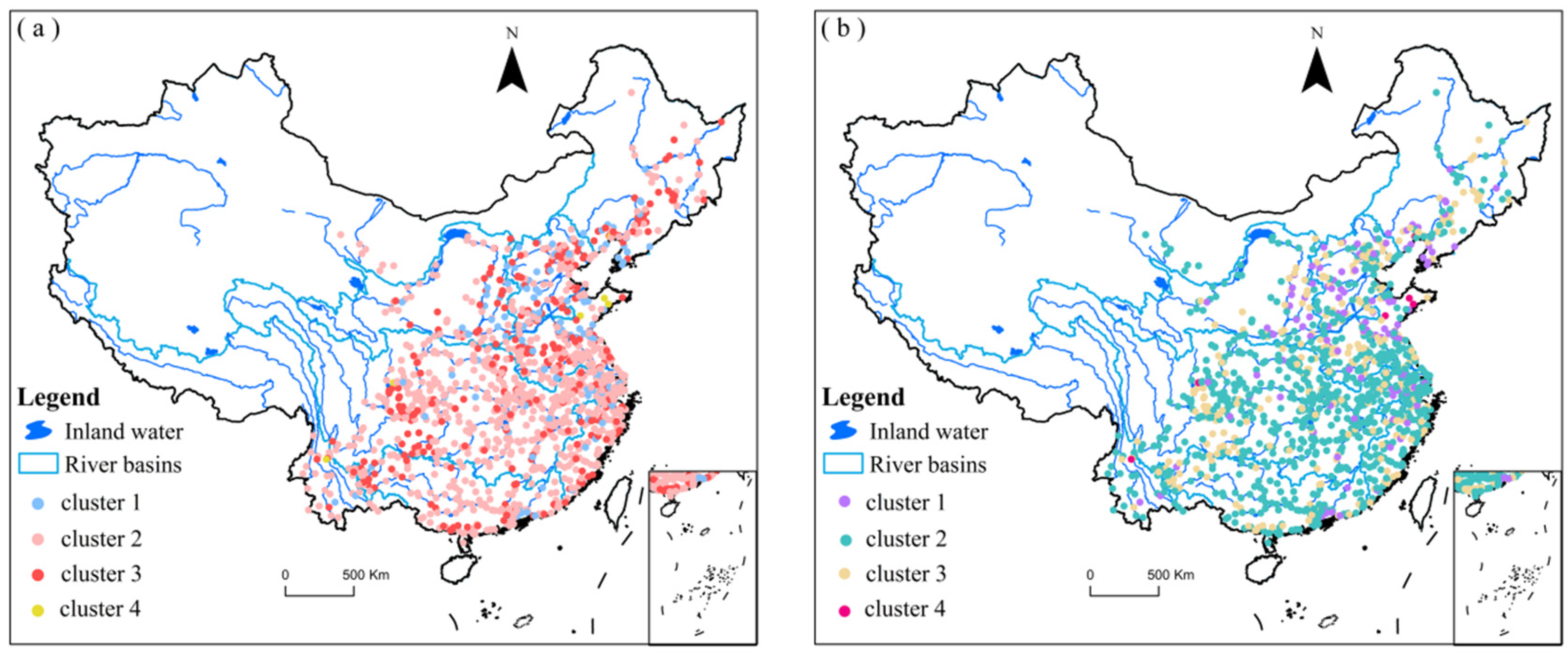
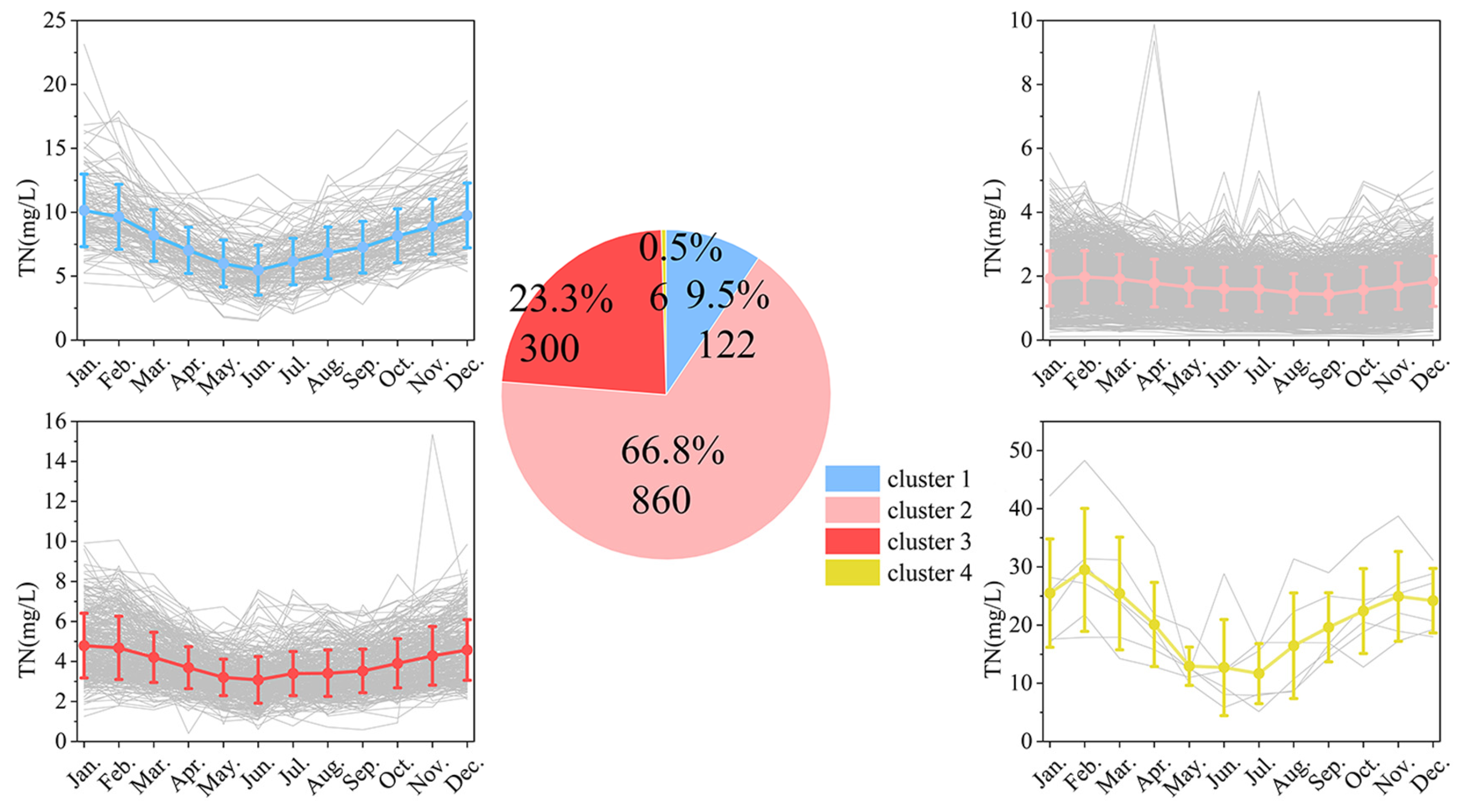


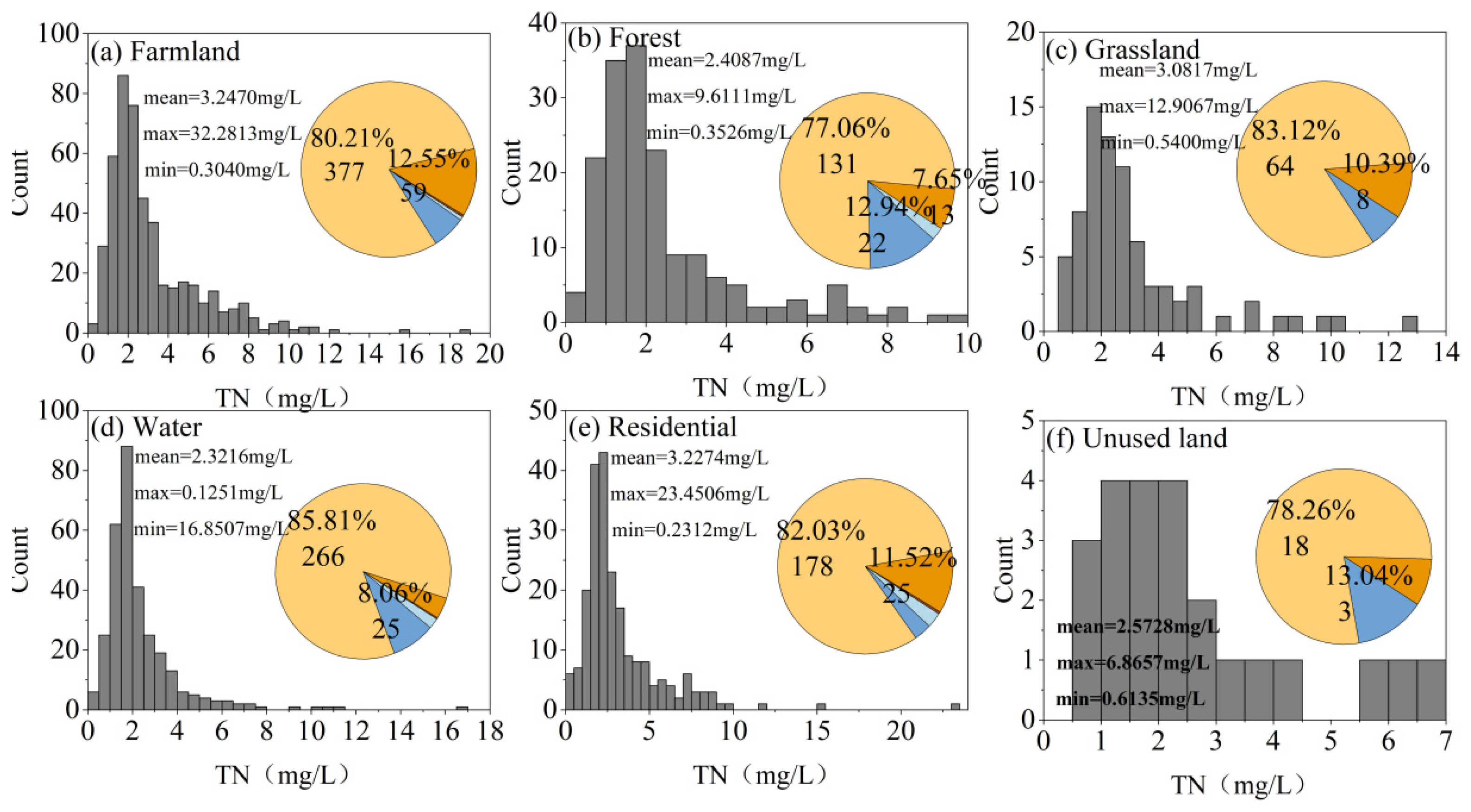
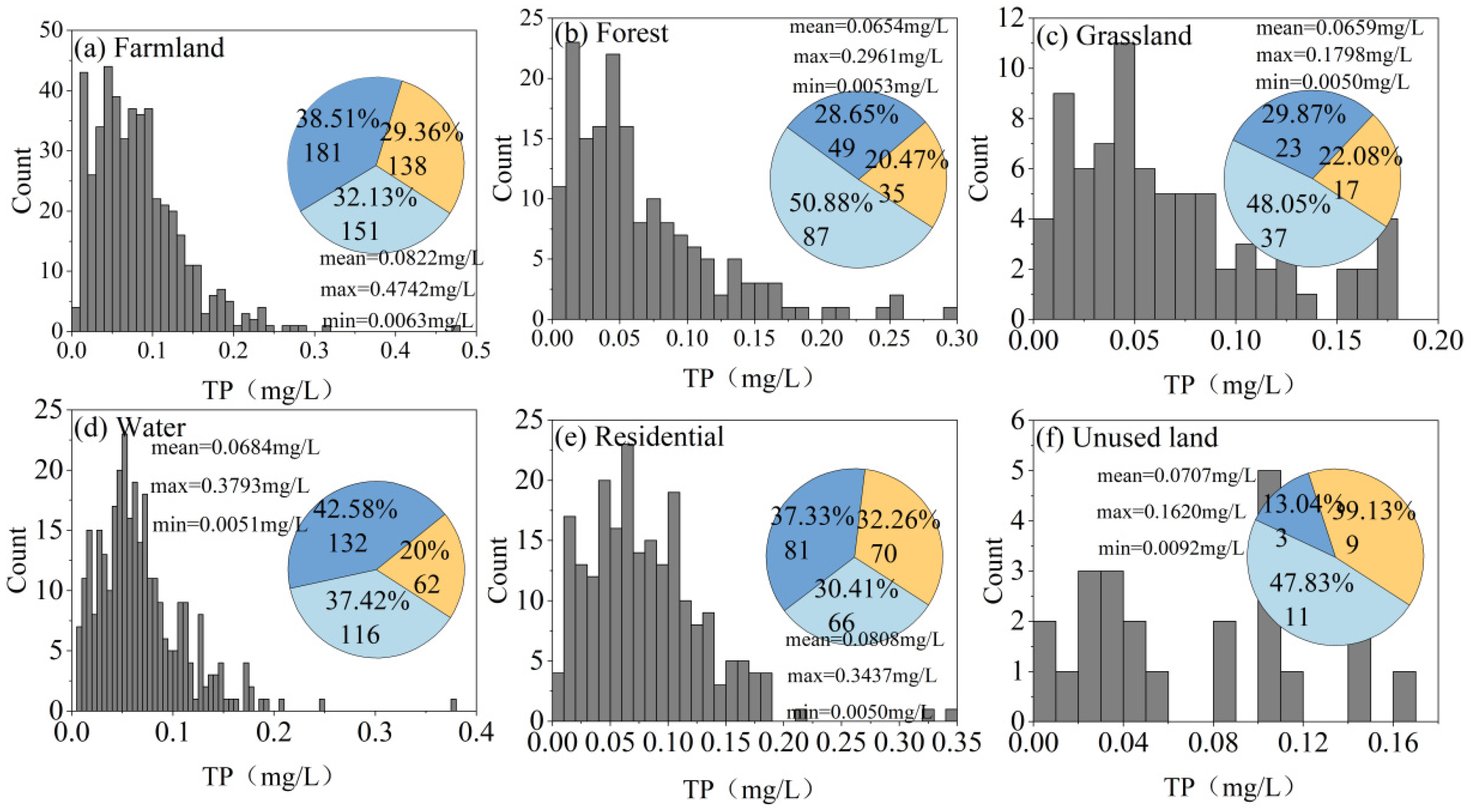
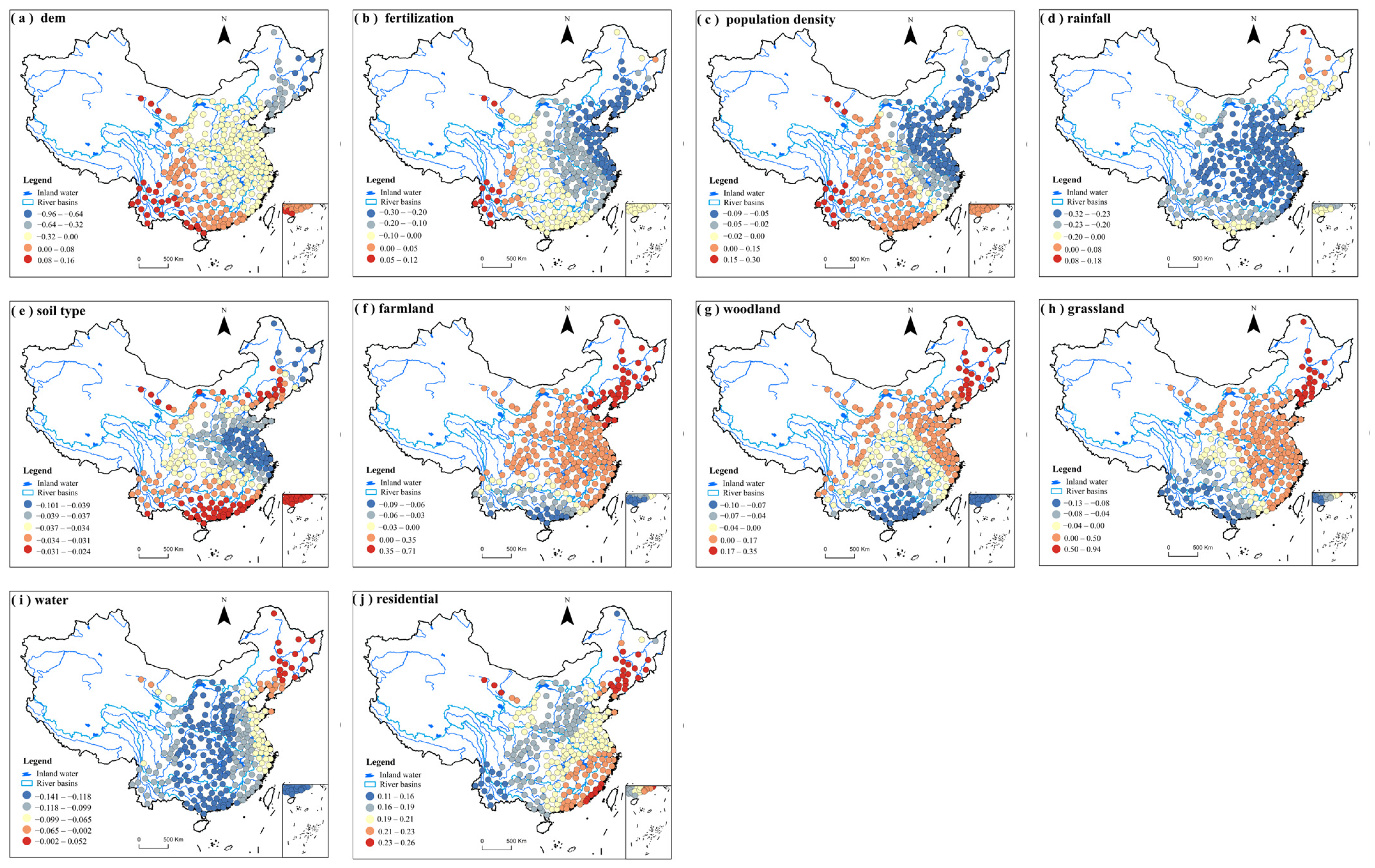
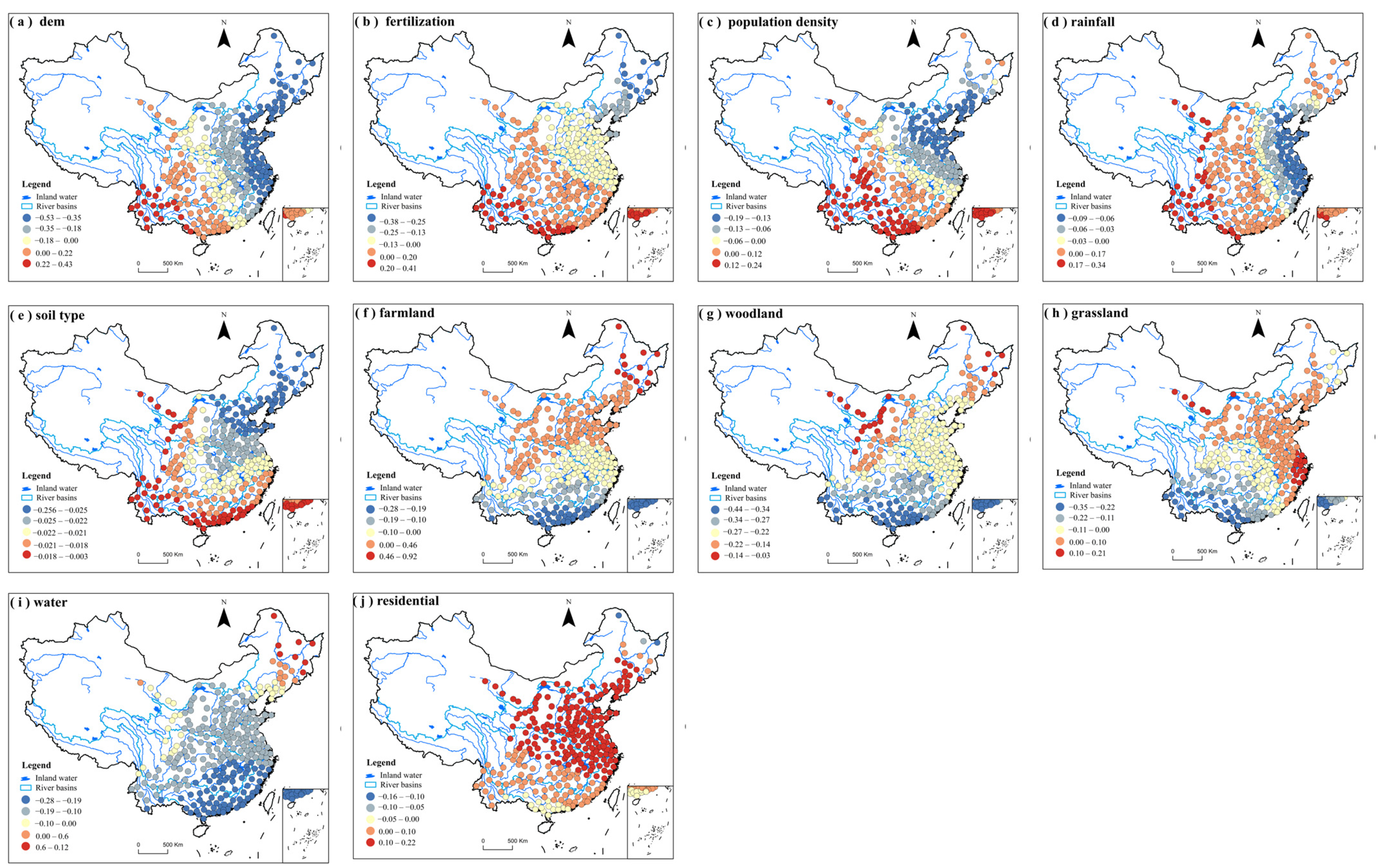
| Name | No. Stations | Basin Area (104 km2) | Average (mg/L) | Max (mg/L) | Min (mg/L) | Std (mg/L) | Number of Measurements |
|---|---|---|---|---|---|---|---|
| Northern inland and Xinjiang rivers | 8 | 333.89 | 1.83 | 2.57 | 1.36 | 0.51 | 96 |
| Northeast river basins | 100 | 124.92 | 4.57 | 18.04 | 0.40 | 2.78 | 1200 |
| Rivers along the southeast coast | 114 | 24 | 1.99 | 4.85 | 0.23 | 0.94 | 1368 |
| Haihe River | 123 | 31.8 | 4.68 | 11.59 | 0.54 | 2.53 | 1476 |
| Huaihe River | 179 | 27.5 | 3.65 | 23.30 | 0.61 | 3.00 | 2148 |
| Yellow River | 93 | 79.5 | 4.77 | 32.74 | 0.47 | 4.15 | 1116 |
| Southwest international river basins | 34 | 85.14 | 1.78 | 8.99 | 0.33 | 1.79 | 408 |
| Yangtze River | 554 | 180 | 1.98 | 11.96 | 0.32 | 1.10 | 6648 |
| Pearl River | 146 | 45.37 | 2.40 | 9.53 | 0.12 | 1.37 | 1752 |
| Name | No. Stations | Basin Area (104 km2) | Average (mg/L) | Max (mg/L) | Min (mg/L) | Std (mg/L) | Number of Measurements |
|---|---|---|---|---|---|---|---|
| Northern inland and Xinjiang rivers | 8 | 333.89 | 0.012 | 0.027 | 0.005 | 0.007 | 96 |
| Northeast river basins | 100 | 124.92 | 0.088 | 0.237 | 0.006 | 0.056 | 1200 |
| Rivers along the southeast coast | 114 | 24 | 0.077 | 0.377 | 0.010 | 0.053 | 1368 |
| Haihe River | 123 | 31.8 | 0.075 | 0.286 | 0.005 | 0.056 | 1476 |
| Huaihe River | 179 | 27.5 | 0.098 | 0.421 | 0.007 | 0.053 | 2148 |
| Yellow River | 93 | 79.5 | 0.070 | 0.271 | 0.005 | 0.059 | 1116 |
| Southwest international river basins | 34 | 85.14 | 0.069 | 0.495 | 0.007 | 0.095 | 408 |
| Yangtze River | 554 | 180 | 0.069 | 0.352 | 0.006 | 0.045 | 6648 |
| Pearl River | 146 | 45.37 | 0.064 | 0.249 | 0.005 | 0.050 | 1752 |
| Name | Spring | Summer | Autumn | Winter | Annual |
|---|---|---|---|---|---|
| Northern inland and Xinjiang rivers | 27 | 126 | 34 | 4 | 48 |
| Northeast river basins | 98 | 514 | 214 | 20 | 211 |
| Rivers along the southeast coast | 636 | 819 | 296 | 214 | 496 |
| Haihe River | 62 | 545 | 156 | 15 | 195 |
| Huaihe River | 165 | 612 | 216 | 65 | 266 |
| Yellow River | 98 | 361 | 189 | 21 | 168 |
| Southwest international river basins | 214 | 690 | 286 | 77 | 318 |
| Yangtze River | 403 | 579 | 237 | 128 | 338 |
| Pearl River | 482 | 809 | 259 | 176 | 436 |
| AICc | R2 | Adjusted R2 | Bandwidth | |
|---|---|---|---|---|
| Basin TN | 123.777 | 0.621 | 0.449 | 17.54 |
| Basin TP | 135.894 | 0.388 | 0.167 | 68.5 |
| Province TN | 111.296 | 0.363 | −0.11 | 67.45 |
| Province TP | 103.23 | 0.528 | 0.177 | 67.45 |
| City TN | 771.748 | 0.276 | 0.206 | 7.48 |
| Downtown TP | 758.814 | 0.317 | 0.247 | 7.08 |
| Variable | Mean | STD | Min | Median | Max |
|---|---|---|---|---|---|
| Intercept | 0.002 | 0.007 | −0.019 | 0.004 | 0.012 |
| Dem | −0.399 | 0.019 | −0.429 | −0.4 | −0.362 |
| Rainfall | −0.469 | 0.066 | −0.586 | −0.484 | −0.315 |
| Population Density | −0.216 | 0.037 | −0.28 | −0.217 | −0.129 |
| Fertilization | −0.133 | 0.055 | −0.235 | −0.14 | −0.036 |
| Soil type | −0.126 | 0.042 | −0.2 | −0.137 | −0.021 |
| Farmland | 0.106 | 0.081 | −0.017 | 0.106 | 0.285 |
| Woodland | 0.038 | 0.065 | −0.096 | 0.029 | 0.172 |
| Grassland | 0.061 | 0.024 | 0.019 | 0.057 | 0.113 |
| Water | 0.126 | 0.072 | −0.029 | 0.133 | 0.279 |
| Residential | 0.357 | 0.03 | 0.307 | 0.358 | 0.423 |
| Variable | Mean | STD | Min | Median | Max |
|---|---|---|---|---|---|
| Intercept | 0 | 0.001 | −0.002 | 0 | 0.001 |
| Dem | −0.492 | 0.004 | −0.501 | −0.491 | −0.485 |
| Rainfall | 0.182 | 0.005 | 0.171 | 0.182 | 0.191 |
| Population Density | −0.278 | 0.002 | −0.282 | −0.279 | −0.276 |
| Fertilization | −0.039 | 0.001 | −0.042 | −0.039 | −0.037 |
| Soil type | −0.085 | 0.003 | −0.092 | −0.085 | −0.079 |
| Farmland | −0.257 | 0.003 | −0.265 | −0.257 | −0.250 |
| Woodland | 0.103 | 0 | 0.102 | 0.103 | 0.104 |
| Grassland | −0.140 | 0.004 | −0.149 | −0.140 | −0.133 |
| Water | 0.054 | 0.001 | 0.052 | 0.054 | 0.057 |
| Residential | 0.212 | 0.002 | 0.208 | 0.212 | 0.217 |
Disclaimer/Publisher’s Note: The statements, opinions and data contained in all publications are solely those of the individual author(s) and contributor(s) and not of MDPI and/or the editor(s). MDPI and/or the editor(s) disclaim responsibility for any injury to people or property resulting from any ideas, methods, instructions or products referred to in the content. |
© 2025 by the authors. Licensee MDPI, Basel, Switzerland. This article is an open access article distributed under the terms and conditions of the Creative Commons Attribution (CC BY) license (https://creativecommons.org/licenses/by/4.0/).
Share and Cite
Li, J.; He, Y.; Xie, T.; Song, Z.; Bai, S.; Zhang, X.; Wang, C. Seasonal Variations and Drivers of Total Nitrogen and Phosphorus in China’s Surface Waters. Water 2025, 17, 512. https://doi.org/10.3390/w17040512
Li J, He Y, Xie T, Song Z, Bai S, Zhang X, Wang C. Seasonal Variations and Drivers of Total Nitrogen and Phosphorus in China’s Surface Waters. Water. 2025; 17(4):512. https://doi.org/10.3390/w17040512
Chicago/Turabian StyleLi, Jian, Yue He, Tao Xie, Zhengshan Song, Shuying Bai, Xuehong Zhang, and Chao Wang. 2025. "Seasonal Variations and Drivers of Total Nitrogen and Phosphorus in China’s Surface Waters" Water 17, no. 4: 512. https://doi.org/10.3390/w17040512
APA StyleLi, J., He, Y., Xie, T., Song, Z., Bai, S., Zhang, X., & Wang, C. (2025). Seasonal Variations and Drivers of Total Nitrogen and Phosphorus in China’s Surface Waters. Water, 17(4), 512. https://doi.org/10.3390/w17040512






